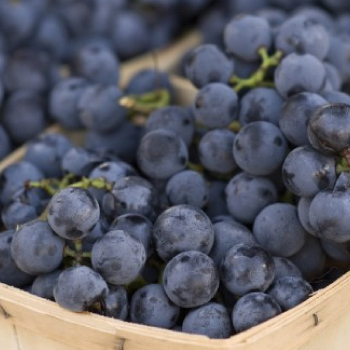
Learning Download: How to Grow Grapes
From Seed to Harvest: A guide to growing grapes.
Gardeners don’t have to live in a vineyard to grow grapes, as grapes can grow in nearly any region throughout the United States.
To plant:
Grapes should be planted in the early spring, when they are dormant. Prior to planting, soak the roots in water for two to three hours. Plant the bare-root varieties, and trim the root back to 6 inches. The grape’s root system grows deeply, so plant them in well-cultivated soil. Upon planting, you also may need to prune the grapes. Prune the plants of all but one stem and cut the buds down to only two. Space roots 6 to 10 feet apart and plant them 12 inches deep. Cover the roots with 6 inches of soil and firmly tamp it down. Fill the remaining space with 6 inches of soil that is loosely settled and not tamped down.
To grow:
Grapes require full sun and well-drained soil. Some type of support, like a trellis, is needed to grow grapes. By training the grape vines, you can direct them to grow in whichever way you want. Pruning also lends a hand in this. You should prune grapes, keep a few stems from last year’s growth and train them along a trellis, but prune off all the remaining stems. Thin any flower clusters that look weak or misshapen so they don’t overproduce fruit, which will cause the fruit to be poor quality. Apply mulch around the vines to retain moisture and deter weeds. To keep birds and other animals away, arrange mesh netting over the vines.
To harvest:
Once grapes are picked from the vine, they will not continue to ripen. They are ripe in the late summer or early fall when they are rich in color, easily crushed but not shriveled, plump and juicy. To harvest, snip clusters of ripe grapes from the vine. Grapes should be tightly attached to their stem. Pick the grapes on a sunny day, which is when they will have the highest sugar content.
What grapes crave:
Grapes don’t require fertilizer in their first year, but in the second year, feed grapes lightly with a nitrogen fertilizer.
Where to buy grape plants:
You can find grape plants at Urban Farmer.
Learning Download: Common pests and diseases: Grapes
Common pests and diseases: Grapes
When growing fruits and vegetables, it is always exciting to care for the plant throughout its growing phase and then harvest it for delicious recipes later on, but one thing to watch out for is pests and diseases. Different plants are susceptible to different types of pests and diseases, and it is important to make yourself aware so you can keep a watchful eye and also take any preventative methods to keep your plants safe throughout their lifespan.
Grapes can fall victim to several different pests and diseases.
Pests:
Some of the most common pests affecting grapes can include Japanese beetles, grape mealbugs and the black vine weevil.
Japanese beetles cause problems to many plants. On grape plants, they affect the roots, leaves and fruit. The beetle’s larvae feed on the roots, and the adults feed on the leaves and fruit. Both larvae and adults cause damage. A symptom is skeletonized leaves. To prevent this problem, use insecticides.
The grape mealybug will cause a sooty mold to grow on the grape fruits. This pest is generally pretty sporadic, and it will secrete a sugary substance on the fruit that then encourages the growth of mold. To manage this, control your ant populations and encourage mealybug population natural enemies. You also can apply appropriate insecticides when necessary.
The black vine weevil will cause feeding damage on the stems, leaves, flowers and buds of the grape plants. A black vine weevil infestation will cause a loss of vigor in plant growth. To manage this problem, grow a cover crop such as red fescue to lessen the chances of black vine weevil infesting your grapes.
Diseases:
Some of the common diseases affecting the grape plant include anthracnose, Armillaria root rot, Botrytis bunch and more.
Anthracnose will cause dark red lesions on the fruit and also sunken gray lesions on the fruit. Lesions on the leaves can cause the leaves to curl. This disease can kill certain parts of the grape plant. Plant less susceptible varieties and apply appropriate fungicides when necessary.
Armillaria root rot causes weak and short shoots, and it also causes a white fungus under the bark at the soil line. This will lead to unproductive vines and causes the plant to rapidly wilt. There are no known grape plants resistant to this disease. To manage this disease, you may need to fumigate in soils suspected of carrying the disease.
Botrytis bunch rot will cause the stem to have brown lesions early in the season and the grapes will become covered in a gray or tan powder. The stems and grapes can shrivel. To manage this disease, plant less susceptible varieties and do not overfertilize. You can try to improve the air circulation.


